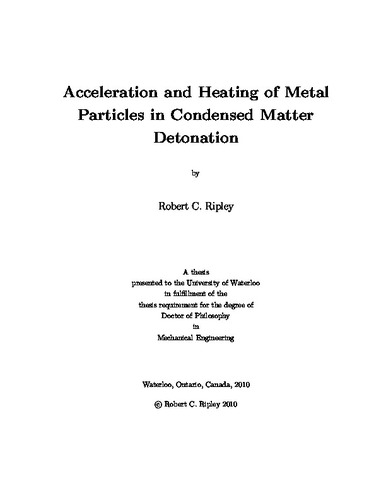| dc.description.abstract | For condensed explosives containing metal particle additives, interaction of the
detonation shock and reaction zone with the solid inclusions leads to non-ideal detonation phenomena. Features of this type of heterogeneous detonation are described and the behaviour is related to momentum loss and heat transfer due to this microscopic interaction.
For light metal particles in liquid explosives, 60-100% of the post-shock velocity and 20-30% of the post-shock temperature are achieved during the timescale of the leading
detonation shock crossing a particle. The length scales corresponding to particle diameter
and detonation reaction-zone length are related to define the interaction into three classes,
bound by the small particle limit where the shock is inert, and by the large particle limit
dominated by thin-detonation-front diffraction. In particular, the intermediate case, where
the particle diameter is of similar order of magnitude to the reaction-zone length, is most
complex due to two length scales, and is therefore evaluated in detail.
Dimensional analysis and physical parameter evaluation are used to formalize the
factors affecting particle acceleration and heating. Examination of experimental evidence,
analysis of flow parameters, and thermochemical equilibrium calculations are applied to
refine the scope of the interaction regime. Timescales for drag acceleration and convective
heating are compared to the detonation reaction time to define the interaction regime
as a hydrodynamic problem governed by inviscid shock mechanics. A computational
framework for studying shock and detonation interaction with particles is presented,
including assumptions, models, numerics, and validation. One- and two-dimensional
mesoscale calculations are conducted to highlight the fundamental physics and determine
the limiting cases. Three-dimensional mesoscale calculations, with up to 32 million mesh
points, are conducted for spherical metal particles saturated with a liquid explosive
for various particle diameters and solid loading conditions. Diagnostic measurements,
including gauges for pressure, temperature, and flow velocity, as well as mass-averaged
particle velocity and temperature, are recorded for analysis.
Mesoscale results for particle acceleration and heating are quantified in terms of shock
compression velocity and temperature transmission factors. In addition to the density ratio
of explosive to metal, the solid volume fraction and the ratio of detonation reaction-zone
length to the particle diameter are shown to significantly influence the particle acceleration
and heating. A prototype heterogeneous explosive system, consisting of mono-disperse spherical aluminum particles saturated with liquid nitromethane explosive, is studied to
develop fitting functions describing the shock compression transmission factors.
Results of the mesoscale calculations are formulated into a macroscopic physical model
describing an effective shock compression drag coefficient and Nusselt number. The novel
models are explored analytically and are then applied to two challenging sets of test cases
with comparison to experiment. Heterogeneous detonation is considered for aluminum
particles saturated with liquid nitromethane, and inert particle dispersal is studied using
a spherical explosive charge containing steel beads saturated in nitromethane. Finally,
discussion of practical considerations and future work is followed by concluding remarks. | en |

